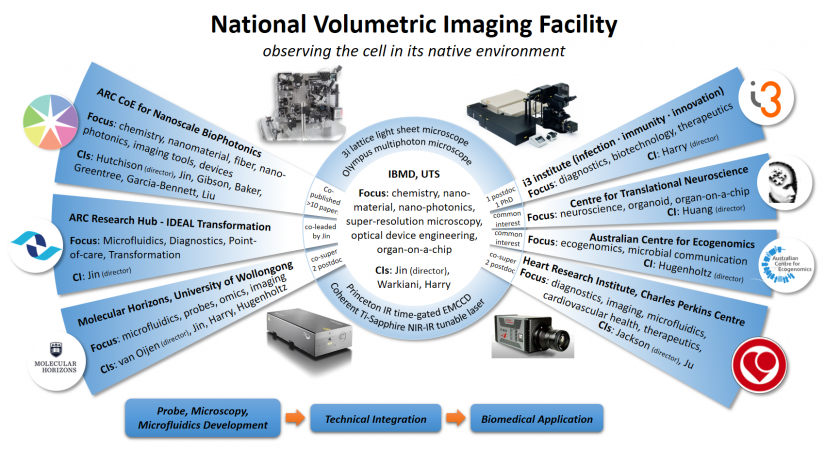Summary
- In a first for Australia, the establishment of a new imaging facility means researchers will be able to watch the inner workings of cells in unprecedented ways
- Known as the National Volumetric Imaging Platform the facility is expected to pave the way for potentially ground-breaking discoveries spanning physical, engineering and life sciences.

The National volumetric Imaging Platform links physical, engineering and biological sciences to support emerging Australian research strengths.
The Australian Research Council (ARC) has announced funding for a super-resolution imaging facility that will be the first of its kind in Australia. The facility brings together a consortium of multidisciplinary researchers from eight Australian universities to develop new capacities for materials science, photonics devices, engineering, and neuroscience, microbial and cardiovascular research.
At its core the A$3.0m ARC LIEF* project will enable scientists to study the inner workings of cells in their native environment. This represents a step change from currently imaging isolated 2D cells cultured in a petri dish to future research that will reveal subcellular structures and cell-to-cell communications in 3D tissue in real time.
The National Volumetric Imaging Platform, as it is known, will be installed, maintained and operated by the Institute for Biomedical Materials and Devices (IBMD) at the University of Technology Sydney (UTS) and the ARC Centre of Excellence for Nanoscale Bio Photonics (CNBP) at RMIT University in Melbourne. This project is scheduled to be completed in late 2019.
UTS Professor Dayong Jin, Lead Chief Investigator of the project, said that the facility will give scientists a "new way to decode the complexities of life science machinery".
"High-resolution imaging of the large volume of single cells and functional navigation of their interactions will allow researchers to drop into a 'street view' and observe the details of intercellular 'live traffic'," he said.
High-resolution imaging of the large volume of single cells and functional navigation of their interactions will allow researchers to drop into a 'street view' and observe the details of intercellular 'live traffic'
Dr Arnold Ju from the University of Sydney added that the new imaging platform will be "like the experience of virtual reality technologies [allowing researchers] to walk inside a living organism".
A highly significant element of the facility is its support for a range of exciting and emerging research strengths in Australia. Synergistic engineering between organoids (mini organs), microfluidics and microscopy tools will accelerate materials and engineering sciences to develop new luminescent probes, photonics imaging techniques and organ-on-chip devices.
"With a multidisciplinary team, we will be able to see cells in the context of how they function within the body. This capability will be transformative for our understanding of disease and how to fight it," said Prof Antoine van Oijen Director of the University of Wollongong Molecular Horizon Institute.
Microbiologist Professor Liz Harry, Director of UTS ithree institute said the facility’s new capabilities means "the complex interactions that bacteria have with their environment and with each other in their mixed community structures, and in their interaction with human cells will begin to be deciphered."
"This is crucial to understanding how bacteria 'decide' to cause infection or to be beneficial bacteria and prevent disease," she said.
Participating Organisations include: Universities: University of Technology Sydney, RMIT University, University of Wollongong, University of Sydney, The University of Queensland, The University of New South Wales, Macquarie University, The University of Adelaide.
Institutes and Centres: Institute for Biomedical and Materials Devices, ARC Research Hub for Integrated Device for End-user Analysis at Low-levels, Institute for Molecular Horizons, the Heart Research Institute, ithree Institute, Centre for Translational Neuroscience, Australian Centre for Ecogenomics, ARC Centre of Excellence for Nanoscale BioPhotonics.
*The ARC LIEF (Linkage Infrastructure, Equipment and Facilities) scheme provides funding for research infrastructure, equipment and facilities to eligible organisations to support research. The scheme enables higher education researchers to participate in cooperative initiatives so that expensive infrastructure, equipment and facilities can be shared between higher education organisations and also with industry.

